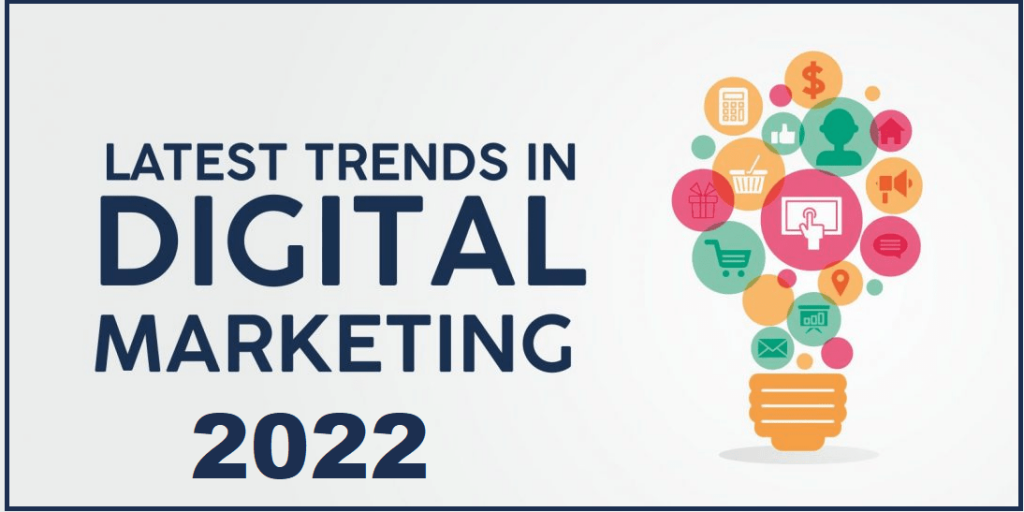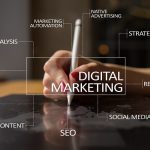As the global pandemic accelerated change over the years, digital transformation has become a reality for enterprises of all types in the past year.
Your digital marketing plan may have been based on out-of-date emerging developments, while brand-new problems have arisen to consume time and attention. Therefore the need for a Digital marketing expert has risen.

The wants and habits of today’s consumers have shifted dramatically. New technology has been introduced this year in an effort to link companies and creators with their intended customer base. New social media platforms such as Clubhouse, which connects people from around the world, were introduced in 2021, making it a significant year in the history of social media. By the summer of 2022, there will be even more than 1.5 billion TikTok users, making it the most popular social media platform in the world right now.
All of the social media platforms have added additional features and ways to buy products. Only Twitter has implemented a shopping tab for brands.
You may be wondering how you can keep up with the ever-changing landscape of digital marketing in 2022.
“You have to stand apart by offering high quality, relevant experiences to audiences that you truly understand.” — Adam Audette.
You can get a sense of the future scenario by looking at the following data:
- Online spending has risen by 20% since January 2020.
- During the epidemic, 30% of buyers want to continue spending money on their houses.
- 75% of shoppers tried out new methods of shopping.
- 27% of COVID’s customers will continue to spend the same amount of money as they did before.
- To maximize efficiency, 55% of organizational new design features are focused on streamlining roles, supply-chain, and methods.”
- Expenditures on digital advertising are expected to rise by 12% in 2020.
- The top three advertisers are Amazon (10%), Facebook (25%), and Google (28%).
Voice Search
Apple’s Siri voice search service was launched in 2011. People have become accustomed to searching for information by speaking into devices like Google Home and Amazon’s Alexa, which have recently made their way into our homes. By Sundar Pichai, Google’s CEO, 20% of searches are conducted using voice.
Let’s see some more facts about voice search.
- Voice search was utilized by 58% of customers to find local companies.
- On a daily basis, 40% utilize voice search technology.
- Every month, one billion voice searches are made.
- 61% of individuals aged 25–64 currently use a speech device.
- 27% of all mobile browsing are voice-activated, indicating they are initiated by a set of “trigger words” such as “how,” “what,” “best,” and “easy.”
There is little doubt that voice search will play an increasingly important role in providing search engine users with accurate and pertinent information. Google Assistant has more than a million actions, whereas Alexa has more than 100,000 skills. These acts and talents are characteristics that allow their voice assistants to answer extremely precisely to the requests and enquiries of their users.
Augmented Reality
In the past few years, the need for innovative and improved shopping experiences has grown. Customers’ perceptions of eCommerce have changed considerably in recent years. Millennials and Gen Z desire to connect with your products virtually before they visit your brick-and-mortar location.
Statista predicts a $209 billion market for augmented and virtual reality by 2022. There is more to it, however. In addition, a poll claims that augmented and virtual reality app downloads worldwide are expected to reach 5.5 billion.
The future holds many things in store that can be done with the help of AR as well as VR, some of them are.
- AR Preview placement: IKEA is a big furniture beast. The company features Augmented Reality software that enables customers to assess and visualize house decor in their surroundings.
- Virtual Showroom: Leading automotive maker, Kia, is taking advantage of virtual reality’s eCommerce advantages. It makes it simpler for customers to find their ideal car by allowing them to view a variety of models in a virtual environment. Customers can virtually test drive their ideal cars in 1:1 size thanks to Kia’s excellent standards for its virtual reality graphics.
- In-store Navigation: A smooth purchasing approach, pinpointing the exact location of a sought item and directing customers to discounted or gift portions can be provided using Augmented reality technology. Lowe’s is one of the major home improvement merchants in the United States that uses in-store navigation software to enhance the directional directions and help clients shop more efficiently.
- Virtual Try-On Solutions: Virtually trying on clothes and shoes is now possible using augmented reality-enabled mirrors. Observe that try-on applications are on the rise, and they are now available for anything from beauty, furniture, accessories, and eyewear to try on.
- Augmented Reality Filter: Augmented reality is already being used by prominent companies like Warby Parker Sunglasses and Sephora (make-up brand). Face-recognition software developed by Sephora lets customers test out several hues of make-up before purchasing them.
“Make it simple. Make it memorable. Make it inviting to look at.” — Leo Burnett
Geofencing
Let’s start by understanding what is Geofencing?
Geofencing is a location-based service that uses GPS, RFID, Wi-Fi, or cellular data to start a pre-programmed action when a mobile device or RFID tag enters or leaves a virtual boundary around a real-world area, called a geofence. This is called geofencing.
A geofence can be set up to send push notifications, SMS messages, or alerts, send targeted ads on social media, track vehicle fleets, disable certain technology, or provide location-based marketing data.
The usage of geofencing, which is anticipated to reach $2.4 billion by 2023, is not new, but we expect an increase in its use in line with the expansion of mobile use. Retailers feel that restaurants and bars, health and beauty shops, entertainment venues, grocery and pet stores are the five major retailer geo-fencing targets, according to Reveal Mobile’s survey.
Digital users will increasingly be converted into brick-and-mortar customers as a result of geo-fencing in marketing campaigns.
The new Metaverse
Facebook’s Mark Zuckerberg, for example, is a believer in the metaverse. A letter from the CEO of Facebook renamed Meta explains the company’s decision to embrace the metaverse. As a hologram, in the future, you will have the ability to travel immediately to work, social gatherings, or even your parent’s living room to catch up on what you missed. “No matter where you live, this will open up more chances for you. With less time spent stuck in traffic and a smaller carbon footprint, you’ll have more time for the things that matter to you,” he added.
They should start preparing for their future duties in this new world now. Think about how your customers may interact with your brand in a variety of ways by combining virtual reality and physical experiences.
Video marketing
There are multifold of the importance of social media marketing. One of them is Video marketing. Mobile-first has been popular for a while now, as I’m sure you’ll agree. As a result, video streaming on mobile devices such as smartphones and tablets has never been easier.
TikTok and Instagram’s reels were popularized in the beginning because of this method. You have complete control over where, when, and how you record your video. Back in the days when mobile data plans were limited to megabytes of the Internet rather than gigabytes, something similar was significantly more expensive.
And the video is a huge hit with viewers.
In 2022, video marketing will unquestionably be a major force in digital marketing. You should definitely start using marketing videos in your digital strategy if you haven’t done so already.
Here are some amazing facts about video marketing.
- 60% of firms use video for advertising themselves.
- 61% of marketers say video is “important or extremely critical” to their marketing plan.
- 74% of respondents believe that video has a higher return on investment than static images.
- 52% of companies say video helps them build trust with potential customers.
Google Lens
You must first scan your phone at an object, such as a flower, in order to make use of this capability. Then ask your Google Assistant for help in identifying it. Even if you don’t obtain the correct response, you’ll also be provided possibilities depending on the object, such as neighbouring florists for a floral arrangement.
Take a picture of the SSID sticker on the back of your Wi-Fi router with Google Lens. You won’t have to do anything else to link your phone to the Wi-Fi network. You won’t be stooping to get the password out of the cabinet while you type it into your phone. With Google Lens, you can now point and shoot.
A pop-up window containing ratings, addresses, and operating hours will appear when Google Lens recognizes restaurants, clubs, cafes, and bars. One of the most remarkable things about this system is its ability to recognize everyday objects.
What can Google Lens do?
- Translate: When you scan text on your device, Google Translate will perform a real-time translation right in front of your eyes. If you want to do this offline, you can do so.
- Shopping: You may use Google Lens to find similar articles of apparel if you find a dress you like while shopping. Whether you’re making a purchase or reading a review, this method works for nearly anything.
- Books: You are able to read the summary of the book you intend to buy as well as the reviews of the book.
- Painting: Who drew the painting? In which era was it painted? And the description of the artist. Inshort, everything you need to know about the painting will be in front of you.
- Search around you: A quick scan of your surroundings using Google Lens is all it takes to get an accurate description. This might be info on a famous landmark or even recipes for various foods.
- Event flyers and billboards: When you scan at the flyer or the billboard nearby you, you can get all the descriptions about that particular thing. Also, you are able to add events to your calendar.
Social commerce
One more importance of social media marketing is Social commerce. Although social commerce has been around for a while, it has only just begun to acquire traction. Social commerce has been completely reimagined by Instagram and TikTok.
Ninety percent of Instagram’s one billion users follow active retail companies, and many of these sites are regularly frequented. On Instagram, you can take advantage of the following features:
Live shopping: Live shopping is a term coined to describe the convergence of video streaming, eCommerce, and social media in one transaction. Online stores can appear and feel like brick-and-mortar establishments thanks to compelling and shoppable content. In this way, businesses are able to transform lengthy product descriptions into conversational threads.
Shop tab ads: eCommerce stores who want to display their adverts on clients’ shop tabs will find this to be an excellent solution.
Reel ads: Instagram‘s latest ad format is a reel. In addition to the usual feed posts, Stories, IGTV, Messenger, and the Explore tab, Instagram offers a wide variety of extra ad places. After a successful pilot programme in a few countries, Reels ads are now available worldwide following the success of the test programme.
IGTV ads: Same as previously, except this time for IGTV.
Instagram checkout: It’s a simple and secure method to sell your things on Instagram directly to customers.
TikTok, which has 1 billion monthly active users, is not far behind with 1 billion monthly active users. After a year and a half, they launched TikTok Shopping, which allows creators to include a shopping page on their TikTok profiles.
Few facts about social commerce:
- As per studies, 97% of Gen Z members attribute their primary source of purchasing impulse to social media.
- While 62% of 13-to-39-year-olds agree on the importance of purchasing products directly from their social media feeds.
Influencer marketing
Influencer marketing is a form of marketing in which businesses, their products, services, and information are promoted through the use of prominent, popular, famous people with social networks, newsgroups, blogs, and messengers.
Influencers can be divided into three types of groups.
- Big influencers: More than a million followers of celebrities, entertainers, and social media influencers who generate between 2% and 5% engagement per post. Their fame gives them clout.
- Macro influencers: People who have an audience of 10,000-1,000,000 people and a participation rate of between 5% and 10% on their posts. It doesn’t matter if they’re in the fashion, leisure, or business worlds, these people have a lot of clouts.
- Micro-influencers: An audience of 500–10,000 followers who engage at a rate of 25–50% on each post. In their respective fields, these are the most influential companies, and their success is directly attributed to their superior expertise.
Make sure to keep in mind the 1-9-90 rule, which states that just 1% of the Internet’s population creates original content, 9% alters that content, and 90% consume it.
In contrast, 9% (transmitters) are made up of micro-influencers, while 1% is made up of macro-influencers. As a result, reaching out to local micro-influencers is the most successful technique for promoting your brand because they will generate the most interest in your product or service.
My final thoughts
It is impossible to predict the future. Time is a precious commodity for marketers. As a result, the only other option is to begin acting in order to deal with uncertainty. As you advance, perhaps your route to success will become more evident.
These digital marketing trends should have provided you with a few ideas for creative campaigns that you may implement in the near future.






